|
 |
 Автор: Williams Автор: Williams
 Дата: 2 марта 2021 Дата: 2 марта 2021
 Просмотров: 10 140 Просмотров: 10 140 |
| |
Dlubal RFEM v5.25.01.158239 x64
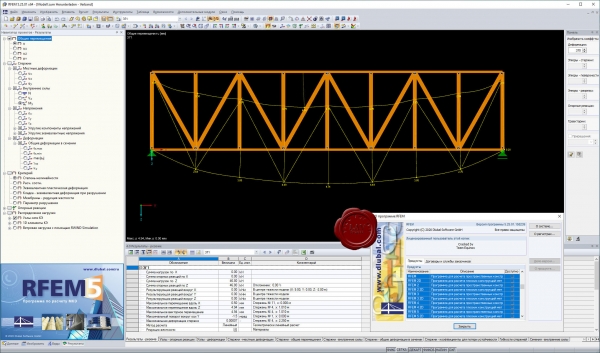
Программа RFEM для расчета методом конечных элементов - это мощное программное обеспечение для быстрого и простого моделирования, структурного анализа и проектирования 2D и 3D моделей, состоящих из стержней, плит, стен, составных плит, оболочек и твердых элементов. Благодаря модульному концепту программного обеспечения, возможно объединение основной программы RFEM с соответствующими дополнительными модулями для удовлетворения ваших индивидуальных требований.
Программа для расчета конструкций RFEM является основой модульного программного комплекса. Базовая программа RFEM используется для задания конструкций, материалов и нагрузок для плоских и пространственных конструктивных систем, состоящих из плит, стен, оболочек и стержней. Возможно создание комбинированных конструкций, а также моделирование объемных и контактных элементов. В программе RFEM рассчитываются деформации, внутренние силы, напряжения, опорные реакции, а также контактные напряжения основания. Дополнительные модули облегчают ввод данных путем автоматического создания конструкций и соединений либо могут выполнять дальнейший анализ и моделирование в соответствии с различными стандартами.
Благодаря широкому спектру интерфейсов RFEM обеспечивает идеальное взаимодействие с программами САПР и расчета конструкций в информационном моделировании зданий (BIM). Например существует двусторонний обмен данными между RFEM и программами Tekla Structures, Revit Structure, Bentley ISM. |
| |
 Читать статью дальше (комментариев - 27)
Читать статью дальше (комментариев - 27)
| |
|
 |
 Автор: Williams Автор: Williams
 Дата: 1 марта 2021 Дата: 1 марта 2021
 Просмотров: 1 890 Просмотров: 1 890 |
| |
Siemens Simcenter FEMAP 2021.1.2
incl. Structural Analysis Toolkit 2021.1
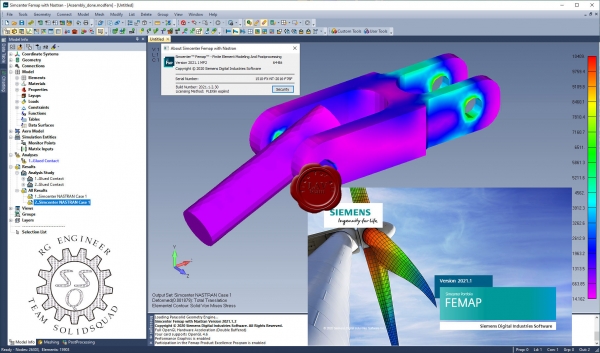
Femap – независимый от САПР пре- и постпроцессор от Siemens PLM Software для проведения инженерного анализа методом конечных элементов (МКЭ) (Finite Element Analysis – FEA). Femap является связующим звеном между пользователем и решателем - ядром, осуществляющим вычисления в задачах инженерного анализа. Система Femap, интегрированная с решателем NX Nastran, входит в линейку продуктов Velocity Series и является независимой полнофункциональной средой для моделирования, имитации и оценки результатов анализа характеристик изделия. Femap 11.3 x64 на базе решателя NX Nastran 10p2 x64 позволяет проводить анализ динамики и прочности конструкций, машин и сооружений, получать решение нестационарных нелинейных пространственных задач, задач механики композитов и композитных структур, строительной и технологической механики, проводить анализ теплопереноса, получать решение задач механики жидкости и газа, связанных многодисциплинарных задач.
Базовые модули Femap с NX Nastran позволяют проводить основные виды инженерного анализа, такие как линейный статический анализ, анализ частот и форм свободных колебаний, анализ потери устойчивости конструкций, анализ задач стационарного и нестационарного теплообмена, базовые возможности нелинейного анализа. Базовый нелинейный анализ включает учет таких нелинейностей, как геометрическая (большие деформации, перемещения, следящие нагрузки) и физическая (учет нелинейных материалов – пластичности, ползучести, вязкоупругости), учет контактного взаимодействия при малых перемещениях – «линейный» контакт, учет контакта с условием сплошности. Расширенный нелинейный модуль (Advanced Nonlinear) используется при анализе больших нелинейностей (в том числе деформирование [Эластомер|эластомеров], учет пространственного контактного взаимодействия), сочетании различных видов нелинейностей, а также при моделировании и расчете быстропротекающих нелинейных динамических процессов на основе явной схемы интегрирования. Femap включает три дополнительных модуля: Femap Flow Solver – позволяет осуществлять анализ гидро- и газодинамики; Femap Advanced Thermal Solver – предоставляет набор возможностей для анализа тепломассопереноса, включая моделирование жидкостных каналов, связанной конвекции и анализ гидро-, газодинамических потоков; Femap Thermal Solver – решение для температурного анализа и анализа теплопереноса. Femap используется специалистами проектных организаций для моделирования сложных конструкций, систем и процессов, таких как, спутники, самолеты, электронная аппаратура военного назначения, тяжелое строительное оборудование, подъемные краны, морской транспорт и технологическое оборудование. Femap обеспечивает решение сложных задач инженерного анализа в различных отраслях, например, таких как авиационно-космическая, вертолетостроение, оборонная промышленность и судостроение. |
| |
 Читать статью дальше (комментариев - 3)
Читать статью дальше (комментариев - 3)
| |
|
 |
 Автор: Williams Автор: Williams
 Дата: 28 февраля 2021 Дата: 28 февраля 2021
 Просмотров: 1 452 Просмотров: 1 452 |
| |
CADprofi 2021.07 build 210221
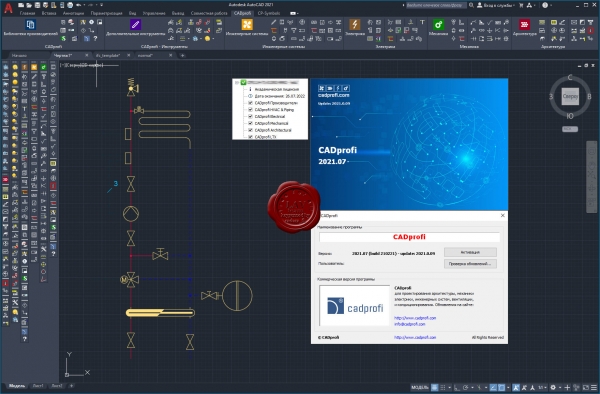
CADprofi HVAC & Piping - параметрическое CAD-приложение для проектирования технического оборудования зданий. Поддерживаются все виды технических установок: отопление, вентиляция, кондиционирование воздуха, трубопроводы и воздуховоды.
CADprofi Mechanical содержит широкий набор унифицированных деталей, стальной арматуры, стальных профилей и других компонентов, соответствующих стандартам DIN, EN, ISO и национальным нормам. Библиотека включает в себя болты, винты, шайбы, гайки, соединения, заклепки, шпильки, уголки, и детали, используемые в конструкции теплообменников и других устройств. Отличный редактор схем и проектов значительно облегчает создание чертежей гидравлических и пневматических систем.
CADprofi Architectural может быть использовано чтобы создать строительные планы, поперечные сечения и вид с фасада. Удобные функции приложения облегчают проектирование многослойных стен, архитектурное определение размеров, и быстрое создание описания конструкций. Модуль включает в себя полную библиотеку окон, дверей, мебели, и других объектов обстановки. Как дополнительная особенность, приложение может использоваться, чтобы проектировать планы эвакуации и пожаротушения.
CADprofi Electrical может быть использовано для проектирования сложных объектов, таких как электроснабжения, освещения, низковольтных систем, телекоммуникации, систем безопасности и антенных установок. Приложение содержит несколько тысяч электрических элементов и символов (светильники, распределительные устройства и многое другое) Приложение предоставляет легкий способ проектировать проводку и кабельные каналы. Среди наиболее полезных функций автоматическая нумерация (адресация) электрических цепей, и удобное проектирование и редактирование схемы подключения проводов.
|
| |
 Читать статью дальше (комментариев - 12)
Читать статью дальше (комментариев - 12)
| |
|
 |
 Автор: Williams Автор: Williams
 Дата: 26 февраля 2021 Дата: 26 февраля 2021
 Просмотров: 2 391 Просмотров: 2 391 |
| |
Robert McNeel & Associates Rhinoceros v7.5.21053.9001 Corporate ENG+RUS build 22.02.2021
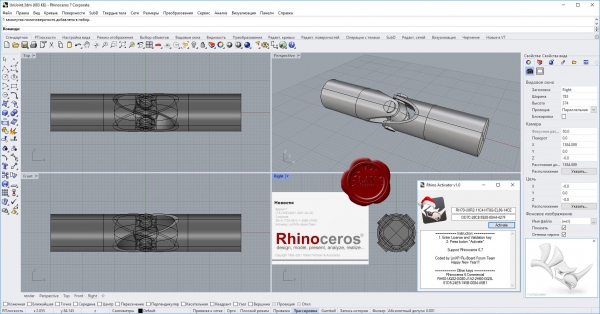
Rhinoceros - профессиональная система концептуального 3D проектирования и моделирования, основанная на технологии AGLib NURBS. Rhinoceros позволяет создавать, редактировать, анализировать кривые, поверхности и твердые тела, и работать с NURBS-объектами. Система эффективно работает объектами любой сложности и размеров. Это может быть моделирование как техническое от клапана до лайнера, так и моделирование биологических объектов от мышонка до человека. Rhinoceros обеспечивает гибкость моделирования благодаря широчайшему набору возможностей рабочей среды. Функциональные возможности системы ставят ее на одну ступень с системами верхнего уровня. Открытость Rhinoceros позволяет легко интегрироваться с любыми CAD/CAM/CAE пакетами.
Rhinoceros is a commercial 3D computer graphics and computer-aided design application software developed by Robert McNeel & Associates. Rhinoceros geometry is based on the NURBS mathematical model, which focuses on producing mathematically precise representation of curves and freeform surfaces in computer graphics (as opposed to polygon mesh-based applications). Rhinoceros is used in processes of computer-aided design (CAD), computer-aided manufacturing (CAM), rapid prototyping, 3D printing and reverse engineering in industries including architecture, industrial design (e.g. automotive design, watercraft design), product design (e.g. jewelry design) as well as for multimedia and graphic design. Rhinoceros is primarily a free form surface modeler that utilizes the NURBS mathematical model. Rhinoceros's application architecture and open SDK make it modular and enable the user to customize the interface and create custom commands and menus. There are dozens of plug-ins available from both McNeel and other software companies that complement and expand Rhinoceros's capabilities in specific fields, such as rendering and animation, architecture, marine, jewelry, engineering, prototyping, and others. |
| |
 Читать статью дальше (комментариев - 13)
Читать статью дальше (комментариев - 13)
| |
|
 |
 Автор: Williams Автор: Williams
 Дата: 25 февраля 2021 Дата: 25 февраля 2021
 Просмотров: 351 Просмотров: 351 |
| |
Simunto Via v20.3
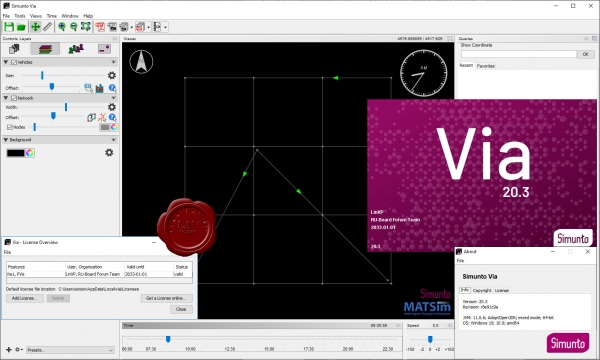
Via allows to work with MATSim data and other large spatio-temporal datasets.
|
| |
 Читать статью дальше (комментариев - 3)
Читать статью дальше (комментариев - 3)
| |
|
 |
 Автор: Williams Автор: Williams
 Дата: 24 февраля 2021 Дата: 24 февраля 2021
 Просмотров: 354 Просмотров: 354 |
| |
Ancestral Systems Clooz v3.6
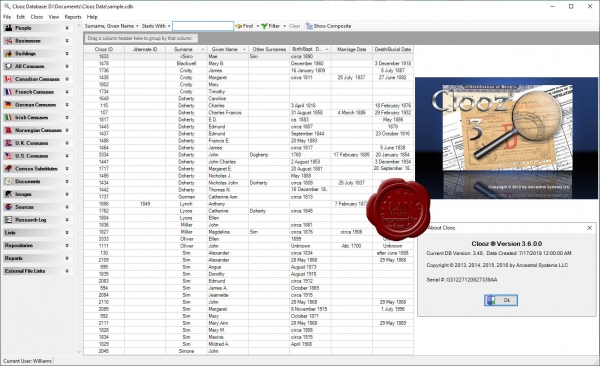
Clooz - организационная программа, разработанная специально для специалистов по генеалогии, позиционирующаяся как «электронный картотечный шкаф». Clooz включает в себя шаблоны для ввода информации из различных стандартных генеалогических документов, таких как записи переписи, а также фотографии, переписку и другие генеалогические записи. Вы можете импортировать и прикрепить цифровую копию исходной фотографии или документа к каждому шаблону, если хотите. Отчеты могут быть созданы для отображения всех документов, содержащихся в Clooz, для конкретного человека или типа записи.
Video guides |
| |
 Читать статью дальше (комментариев - 2)
Читать статью дальше (комментариев - 2)
| |
|
 |
 Автор: Williams Автор: Williams
 Дата: 23 февраля 2021 Дата: 23 февраля 2021
 Просмотров: 5 776 Просмотров: 5 776 |
| |
nanoSoft nanoCAD 20: PLUS, SPDS, MECHANICS v20.0.5094.0501 x64
nanoCAD – российская САПР-платформа, содержащая все необходимые инструменты базового проектирования. Знакомый интерфейс, прямая поддержка формата *.dwg и расширяемость делают nanoCAD лучшей на сегодня альтернативой при выборе инженерной платформы для любой отрасли. Российская универсальная САПР-платформа, содержащая все необходимые инструменты базового проектирования, выпуска чертежей и разработки приложений с помощью открытого API. Знакомый интерфейс, непосредственная поддержка формата *.dwg и расширяемость делают ее альтернативой №1 при переходе на новые базовые решения. Платформа nanoCAD постоянно развивается и совершенствуется. При разработке восьмой версии основное внимание было уделено повышению точности математического аппарата и удобства работы с программой, развитию корпоративных функций и интеграции с BIM-системами.
Torrent is updated with the new extended license file.
|
| |
 Читать статью дальше (комментариев - 19)
Читать статью дальше (комментариев - 19)
| |
|
 |
 Автор: Williams Автор: Williams
 Дата: 20 февраля 2021 Дата: 20 февраля 2021
 Просмотров: 6 042 Просмотров: 6 042 |
| |
Blue Marble Global Mapper v22.1.0 build 021721 x32+x64
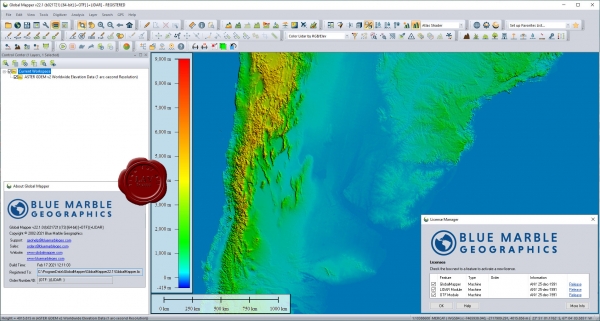
Вышла новая версия программы для просмотра карт и векторных изображений - Global Mapper v22.1.0
Global Mapper позволяет не только просматривать но и преобразовывать или редактировать, а даже и распечатывать всевозможные карты и векторные наборы данных. Global Mapper позволяет вам загружать ваши данные как слои ( только с условием, что вы работаете в Digital Elevation Model), или же как отсканированную карту, если вам надо изобразить местность в 3D. Есть также хорошая особенность, что позволяет вести работу в реальном времени. Происходит это путем загрузки данных с GPS приемника который подключен к компьютеру.
Global Mapper поддерживает огромнейшее число форматов. Работать с ней легко и просто, интерфейс не перенасыщен различными опциями, вы можете смело работать в ней и не задумываться о том, куда нажать, что бы сделать что - то. |
| |
 Читать статью дальше (комментариев - 32)
Читать статью дальше (комментариев - 32)
| |
|
 |
| ПОИСК ПО САЙТУ |
 |
|
 |
| КАЛЕНДАРЬ | | |
 |
| « Октябрь 2025 » |
|---|
| Пн | Вт | Ср | Чт | Пт | Сб | Вс |
|---|
| | 1 | 2 | 3 | 4 | 5 | | 6 | 7 | 8 | 9 | 10 | 11 | 12 | | 13 | 14 | 15 | 16 | 17 | 18 | 19 | | 20 | 21 | 22 | 23 | 24 | 25 | 26 | | 27 | 28 | 29 | 30 | 31 | |
|
 | |
| |
|